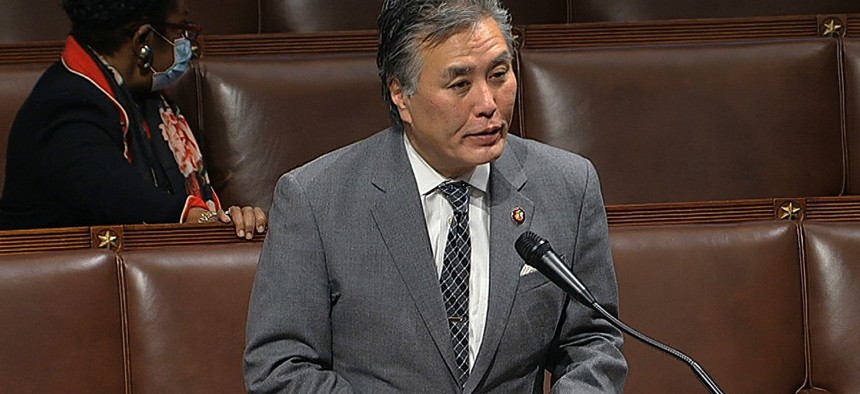
“VA has a diversity problem in its most senior ranks,” says Rep. Mark Takano, D-Calif. House Television via AP
VA Seeks 125% Increase in Diversity and Inclusion Counselors
Lawmakers, stakeholders note that the Veterans Affairs Department has a long way to go to ensure equity in its workforce, particularly within senior executive ranks.
The Veterans Affairs Department is preparing to significantly boost efforts to diversify its workforce and promises to add staff and resources to improve oversight of equity initiatives across its vast network of facilities and programs.
Lawmakers, outside stakeholders and department officials all suggested at a House Veterans Affairs Committee hearing on Thursday that VA has a long way to go to ensure fairness within its workforce, noting the available data show inequality is still prevalent and allegations of discrimination are not promptly handled. VA is fielding about 5,700 informal equal employment opportunity complaints annually and 2,500 formal ones, while addressing just above 50% of them.
Harvey Johnson, VA’s deputy assistant secretary for resolution management, diversity and inclusion, said he is capped at 38 counselors across the department who assist local facilities in addressing those claims. He is hoping to grow that number to 86, some of which Congress has already budgeted. Those counselors can proactively provide assistance to the aggrieved employee, unions and management and help address complaints promptly.
Johnson noted that VA has launched a “technical assistance review” initiative to ensure each VA facility has a “model EEO program,” but it has just one employee to conduct them. He said VA is seeking a budget increase to get a dozen more specialists who can engage with facilities, meet with management and hold focus groups.
Rep. Mark Takano, D-Calif., noted that VA’s leadership is significantly less diverse than its workforce as a whole.
“For too long, VA has failed to take actions on barriers for its employees,” Takano said. “VA has a diversity problem in its most senior ranks. In an organization as large and decentralized as VA, diversity among these senior leaders is critical.”
About half of those in Senior Executive Service and equivalent positions at VA are white males, according to the department’s most recent diversity and inclusion strategic plan, though they make up just 23% of the overall workforce. Black women comprise less than 6% of senior executives, compared to 17% of the workforce. Like the Biden administration as a whole, VA Secretary Denis McDonough has committed to diversifying the department’s workforce and rooting out discrimination.
Rep. Chris Pappas, D-N.H., who chairs the Oversight and Investigations panel that held Thursday’s hearing, said VA must improve to fulfill its mission.
“We all agree that a more diverse, equitable and inclusive VA is both a moral imperative and a business imperative,” Pappas said. “It’s good for people and it’s good for the mission of VA and the veterans that VA serves.”
Several witnesses testifying before the subcommittee expressed gratitude that VA is committing to diversity initiatives, but stressed they are waiting for tangible results before they offer too much praise. VA has made promises before, they noted, but has failed to deliver adequate data to measure progress. Sheila Elliot, who leads the American Federation of Government Employees chapter at Hampton Medical Center in Virginia, said VA has not followed through on its rhetoric on issues such as reasonable accommodations for disabled workers.
“We’re checking off boxes, but we’re not really addressing the root cause,” Elliot said. “Our managers and human resources people are not buying into it, and that needs to change.”
Johnson said VA is engaging in “ambitious things” to ensure department employees feel welcomed. He vowed to work with all stakeholders, including union representatives, to address ongoing inequality in the department.
“It will get done,” he said.







